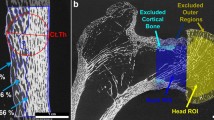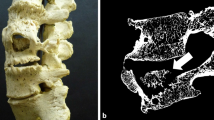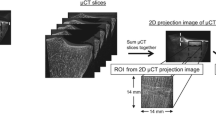Abstract
Objective
Osteomyelitis is an inflammation of the bone marrow mainly caused by bacteria such as Staphylococcus aureus. It typically affects long bones, e.g. femora, tibiae and humeri. Recently micro-computed tomography (μCT) techniques offer the opportunity to investigate bone micro-architecture in great detail. Since there is no information on long bone microstructure in osteomyelitis, we studied historic bone samples with osteomyelitis by μCT.
Materials and methods
We investigated 23 femora of 22 individuals suffering from osteomyelitis provided by the Collection of Anatomical Pathology, Museum of Natural History, Vienna (average age 44 ±19 years); 9 femora from body donors made available by the Department of Applied Anatomy, Medical University of Vienna (age range, 56–102 years) were studied as controls. Bone microstructure was assessed by μCT VISCOM X 8060 II with a minimal resolution of 18 μm.
Results
In the osteomyelitic femora, most prominent alterations were seen in the cortical compartment. In 71.4 % of the individuals with osteomyelitis, cortical porosity occurred. 57.1 % of the individuals showed cortical thinning. In 42.9 % trabecularisation of cortical bone was observed.
Conclusion
Osteomyelitis is associated with severe alterations of cortical bone structure otherwise typically observed at old age such as cortical porosity and cortical thinning.





Similar content being viewed by others
References
Ortner DJ. Infectious diseases: introduction, biology, osteomyelitis, periostitis, brucellosis, glanders, and septic arthritis. In: Ortner DJ, editor. Identification of pathological conditions in human skeletal remains. 2nd ed. San Diego: Academic Press; 2003. p. 181–206.
Waldvogel FA, Medoff G, Swartz MN. Osteomyelitis: a review of clinical features, therapeutic considerations and unusual aspects: 3. osteomyelitis associated with vascular insufficiency. N Engl J Med. 1970;282(6):316–22.
Cierny 3rd G, Mader JT, Penninck JJ. A clinical staging system for adult osteomyelitis. Clin Orthop Relat Res. 2003;414:7–24.
Adler C-P. Inflammatory conditions of bone. In: Bone diseases: macroscopic, histological, and radiological diagnosis of structural changes in the skeleton. English ed. Berlin: Springer; 2000. p. 129–63.
Calhoun JH, Manring MM, Shirtliff M. Osteomyelitis of the long bones. Semin Plast Surg. 2009;23(2):59–72.
Peyrin F. Evaluation of bone scaffolds by micro-CT. Osteoporos Int J. 2011;22(6):2043–8.
Weber GW, Bookstein FL. Mapping the physical world: digitise. In: Virtual anthropology: a guide to a new interdisciplinary field. New York: Springer; 2011. p. 37–94.
Ruhli FJ, Kuhn G, Evison R, Muller R, Schultz M. Diagnostic value of micro-CT in comparison with histology in the qualitative assessment of historical human skull bone pathologies. Am J Phys Anthropol. 2007;133(4):1099–111.
Xu Y, Li D, Chen Q, Fan Y. Full supervised learning for osteoporosis diagnosis using micro-CT images. Microsc Res Tech. 2013;76(4):333–41.
Owen WB. The diagnosis and treatment of osteomyelitis. Ann Surg. 1936;103(6):1007–14.
Key JA. Penicillin and sulfonamides in the treatment of osteomyelitis and pyogenic arthritis. Bull N Y Acad Med. 1945;21(2):87–98.
Butler EC. Staphylococcal septicaemia: osteomyelitis of pelvis—recovery. Proc R Soc Med. 1944;38(2):68–9.
Steinmann WF. Makroskopische präparationsmethoden in der medizin. Stuttgart: Thieme, 1982.
Zebaze RM, Ghasem-Zadeh A, Bohte A, Iuliano-Burns S, Mirams M, Price RI, et al. Intracortical remodelling and porosity in the distal radius and post-mortem femurs of women: a cross-sectional study. Lancet. 2010;375(9727):1729–36.
Boyce BF. Bone and immune cell interaction. In: Rosen CJ, editor. Primer on the metabolic bone diseases and disorders of mineral metabolism. 8th ed. Ames, IA: Wiley-Blackwell; 2013. p. 1036–40.
Khosla S. Pathogenesis of age-related bone loss in humans. J Gerontol A: Biol Med Sci. 2013;68(10):1226–35.
Krappinger D, von Linde A, Rosenberger R, Glodny B, Blauth M, Niederwanger C. Volumetric analysis of corticocancellous bones using CT data. Skelet Radiol. 2012;41(5):503–8.
Feik SA, Thomas CD, Clement JG. Age-related changes in cortical porosity of the midshaft of the human femur. J Anat. 1997;191(Pt 3):407–16.
Gabet Y, Bab I. Microarchitectural changes in the aging skeleton. Curr Osteoporos Rep. 2011;9(4):177–83.
Jilka RL. The relevance of mouse models for investigating age-related bone loss in humans. J Gerontol A: Biol Med Sci. 2013;68(10):1209–17.
Nicks KM, Amin S, Atkinson EJ, Riggs BL, Melton 3rd LJ, Khosla S. Relationship of age to bone microstructure independent of areal bone mineral density. J Bone Miner Res. 2012;27(3):637–44.
Riggs BL, Wahner HW, Dunn WL, Mazess RB, Offord KP, Melton 3rd LJ. Differential changes in bone mineral density of the appendicular and axial skeleton with aging: relationship to spinal osteoporosis. J Clin Invest. 1981;67(2):328–35.
Pietschmann P, Skalicky M, Kneissel M, Rauner M, Hofbauer G, Stupphann D, et al. Bone structure and metabolism in a rodent model of male senile osteoporosis. Exp Gerontol. 2007;42(11):1099–108.
Krappinger D, Roth T, Gschwentner M, Suckert A, Blauth M, Hengg C, et al. Preoperative assessment of the cancellous bone mineral density of the proximal humerus using CT data. Skelet Radiol. 2012;41(3):299–304.
Acknowledgements
The author is indebted to Mag. U. Föger-Samwald for her help with this study and to Prof. Dr. Gerhard Spitzer, Department of Theoretical Biology University of Vienna, for helpful advice with the statistical analyses; and to Paul Chivers, teacher at The Cambridge Institute Vienna for proofreading and help with the use of English.
Conflict of interest
The authors declare that they have no conflict of interest.
Author information
Authors and Affiliations
Corresponding author
Additional information
This work was performed as part of a master’s thesis at the University of Vienna.
Rights and permissions
About this article
Cite this article
Lamm, C., Dockner, M., Pospischek, B. et al. Micro-CT analyses of historical bone samples presenting with osteomyelitis. Skeletal Radiol 44, 1507–1514 (2015). https://doi.org/10.1007/s00256-015-2203-8
Received:
Revised:
Accepted:
Published:
Issue Date:
DOI: https://doi.org/10.1007/s00256-015-2203-8




